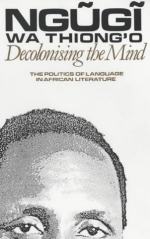
|
| Name: _________________________ | Period: ___________________ |
This test consists of 15 multiple choice questions and 5 short answer questions.
Multiple Choice Questions
1. Who wrote In the Castle of My Skin?
(a) Gabriel Okara.
(b) Kim Chi Ha.
(c) Amos Tutuola.
(d) George Lamming.
2. What character in Caitaani mũtharaba-Inĩ moves in a matatu taxi from Nairobi to Ilmorog?
(a) Munira.
(b) Abdulla.
(c) Nyakinyua.
(d) Warĩĩnga.
3. Who wrote The Wretched of the Earth?
(a) Frantz Fanon.
(b) Vladimir Lenin.
(c) Alan Paton.
(d) Gakaara wa Wanjaũ.
4. The author asserts in Chapter 3, Part IX that the reception of a work of art is what?
(a) Secondary to the work itself.
(b) Part of the work itself.
(c) Not of concern.
(d) Important to understanding audience.
5. Who wrote The Master and Margarita?
(a) Kim Chi Ha.
(b) Mikhail Bulgakov.
(c) Amos Tutuola.
(d) Gabriel Okara.
6. What novel did the author's headmaster at Alliance High School admonish for introducing sex sequences between whites and blacks in South Africa?
(a) A Meeting in the Dark.
(b) Devil on the Cross.
(c) Too Late the Phalarope.
(d) Mother Sing for Me.
7. What was the author's fourth novel in English?
(a) Petals of Blood.
(b) The River Between.
(c) Weep Not, Child.
(d) A Grain of Wheat.
8. Who wrote Cry, the Beloved Country?
(a) Alan Paton.
(b) Amos Tutuola.
(c) Obi Wali.
(d) Chinua Achebe.
9. What was the name of the journal in the Gĩkũyũ language that Gakaara wa Wanjaũ established after being released from prison?
(a) Kĩgũũnda.
(b) Maitũ Njugĩra.
(c) Matigari ma Njiruungi.
(d) Gĩkũyũ Na Mũmbi.
10. Who does the author refer to as the two most outstanding critical minds that might have made his study of English Literature really meaningful?
(a) Martin Carter and Kim Chi Ha.
(b) Arnold Kettle and Raymond Williams.
(c) Gabriel Okara and Birago Diop.
(d) Amos Tutuola and Frantz Fanon.
11. Makerere University College, Ibadam University College, and the Ghana University College were all overseas colleges under the umbrella of what institution?
(a) Oxford University.
(b) The University of Leeds.
(c) The King's College.
(d) The University of London.
12. What country's government does the author describe as having a Literature Bureau that would not publish an African noel which had any but religious themes and sociological themes free from politics in Chapter 3, Part IV?
(a) Rwanda.
(b) Sudan.
(c) Rhodesia.
(d) Ethiopia.
13. Who is the protagonist in Cry, the Beloved Country?
(a) Stephen Kumalo.
(b) Wanja.
(c) Nyakinyua.
(d) Nderi wa Riera.
14. When was Caitaani Mutharabaini published?
(a) 1975.
(b) 1985.
(c) 1980.
(d) 1982.
15. In the author's analysis of the philosophical base of a person's perspective in Chapter 4, Part VII, he asks whether a person's standpoint is idealist or what?
(a) Objectivist.
(b) Realist.
(c) Materialist.
(d) Leftist.
Short Answer Questions
1. Who wrote The Pilgrim's Progress?
2. Who was the military dictator and President of the Democratic Republic of the Congo/Zaire from 1965 to 1997?
3. What metaphor does the author present to describe the differences of perception in Chapter 4, Part I?
4. Who is described in Chapter 4, Part IX as a German visionary how the money taken from the worker and the poor had come to dominate human relations?
5. What novel of the author's is comprised of stories within stories in a series of flashbacks?
|
This section contains 530 words (approx. 2 pages at 300 words per page) |

|




